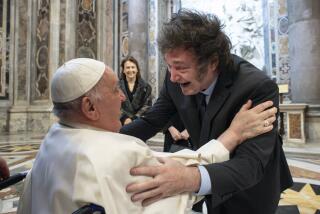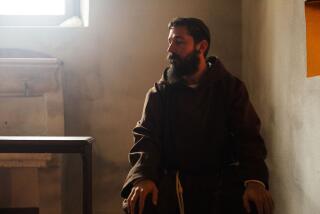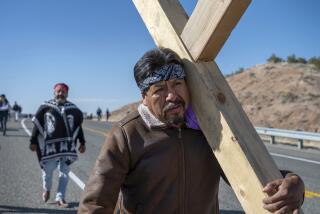‘Lily of the Mohawks’ to be canonized first Native American saint
- Share via
In the 17th century, she was known as “Lily of the Mohawks,” a Catholic convert scarred by smallpox and ostracized by her tribe but unshaken in her faith.
After Sunday, she will be known as St. Catherine Tekakwitha, the first Native American to be canonized by the Roman Catholic Church.
Catholic faithful — from California to New York and Canada to Mexico — have been flooding into Rome to witness Kateri Tekakwitha’s canonization by Pope Benedict XVI on Sunday. She will join six other beatified Catholics being lifted into sainthood, including Mother Marianne Cope, a member of the Sisters of St. Francis who in 1883 volunteered to travel to Hawaii from New York to work with leprosy patients on the island of Kalaupapa.
FOR THE RECORD:
Catholic saints: An article in Section A on Oct. 21 about the canonization of seven new saints said that Mother Marianne Cope, a member of the Sisters of St. Francis, worked with leprosy patients on the island of Kalaupapa in Hawaii. Kalaupapa is a town on the island of Molokai.
In preparation for Sunday’s ceremony in Vatican City, immense tapestries bearing the images of the new saints have been hung from St. Peter’s Basilica.
“We’ve been praying every morning for this for 12 years,” said Msgr. Michael Slattery of St. Kateri Tekakwitha Catholic Church in Santa Clarita.
Slattery is hosting an afternoon Mass on Sunday that Cardinal Roger Mahony is expected to attend.
“It was really ecstatic when the final miracle had been approved by the Vatican for canonization,” the monsignor said Saturday. “She doesn’t just belong to any particular group. Her attributes and her virtue and dedication ... she’s a great person for people to imitate.”
For some Native Americans, Tekakwitha’s canonization carries a significance that goes beyond her Catholic faith. Tekakwitha is known as the patroness of ecology and nature, and her sainthood can also be viewed as a celebration of Native American spiritual traditions, said Juana Majel Dixon of the National Congress of American Indians.
“It’s the combining of all things nature and of things natural,” Majel Dixon said.
Tekakwitha showed the importance of letting spirituality infuse all aspects of life, what Majel Dixon called the “core principles and values of walking in a sacred manner and living a sacred manner and knowing all spaces are sacred.” Such a world view, she said, acknowledges the creator. “We can celebrate that,” she said.
As recounted by the Vatican and many historians, Tekakwitha’s life began in 1656 in what today is Auriesville in upstate New York on the southern bank of the Mohawk River. The daughter of an Algonquin mother and a Mohawk chief, she was orphaned at age 4 when smallpox killed her parents and brother.
The name Tekakwitha — she was simply Kateri before — was a result of her badly damaged eyesight that accompanied her smallpox scars. It means “she who bumps into things.”
She had been introduced to Catholicism by her mother and held fast to her faith when she and her foster family moved to the north riverbank after their village was destroyed in war.
Tekakwitha studied her faith in secret until she was baptized at 18 near present-day Fonda, N.Y., where there is now a national Kateri Tekakwitha shrine. Employees there organized an evening Mass on Saturday and a celebratory gathering Sunday.
Over time, Tekakwitha was ridiculed for her beliefs and she fled to Canada.
After she died at age 23, a priest reported what is regarded as a miracle — the scars on her face vanished and her skin took on a youthful appearance. Villagers reported seeing visions of her reassuring them she was going to heaven, and for years afterward, the earth she touched was used to treat people’s ills. She had settled at the Mission of St. Francis Xavier with a group of Christian Indians in Quebec. A shrine stands in her name there too.
“The whole mission wanted to go to Rome,” said Ann Marie Sky, a volunteer at the Canadian mission, Saturday. “It’s just unbelievable. We’ve been overwhelmed with people coming to visit the mission.... I think it’s sort of revitalized our community, revitalized our faith. Even people who aren’t Catholic are coming together.”
Tekakwitha was approved for sainthood late last year after the Vatican attributed a second confirmed miracle to her name.
In 2006, 6-year-old Jake Finkbonner was on his deathbed. The Washington state native and member of the Lummi Nation had contracted the flesh-eating bacteria infection necrotizing fasciitis through a cut in his lip.
A priest had given him his last rites and his parents had resigned themselves to his death. But after they prayed to Tekakwitha — who was beatified by Pope John Paul II in 1980 — the bacteria stopped spreading and Jake recovered.
The bacteria had traveled too fast, the church found, for there to be any explainable, scientific reason for him to recover.
Like Tekakwitha, he carries scars from his affliction and, again like her, also retains his faith. The Finkbonner family, along with hundreds of others who pray to Tekakwitha, will be at Sunday’s ceremony.
ALSO:
Oregon man to be charged with woman’s killing
Space shuttle Atlantis’ final trip short but still a challenge
Man charged with dropping Molotov cocktail at Virginia mall
More to Read
Sign up for Essential California
The most important California stories and recommendations in your inbox every morning.
You may occasionally receive promotional content from the Los Angeles Times.











